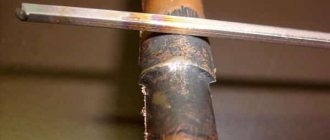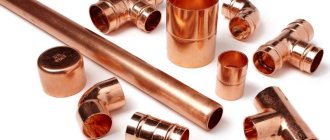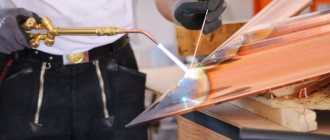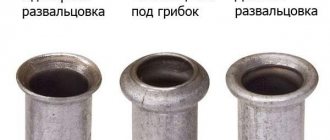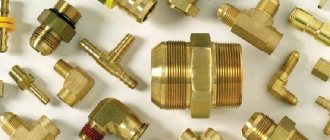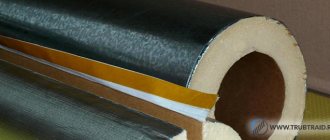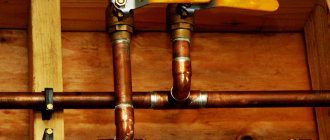For the manufacture of water supply, sewerage, heating in apartments and private houses, pipes from different materials are used. Copper is considered one of the best. This material has many strengths. To make a system with a complex configuration, a pipe bender for copper pipes is used. You can buy this tool at a hardware store or make it yourself.
Pipe bender for copper pipes
Features of copper pipes and their application
Copper pipes are used in the construction and industrial sectors. This is due to the strengths of the material. Advantages:
- The parts can withstand heavy loads and mechanical stress.
- Plaque does not accumulate on the inner walls.
- Low coefficient of linear expansion.
- Rust does not form on copper surfaces.
- The material is resistant to the proliferation of pathogens that may enter the water.
- Copper is not destroyed under the influence of ultraviolet radiation or aggressive environments.
The main disadvantage of copper tubes is their high cost.
Pipe benders for copper pipes
cutting
Pipe cutters for copper pipes Pipe cutters for steel pipes Scissors and pipe cutters for plastic pipes Pipe cutters for metal-plastic pipes Saws/cutting devices
Bending
Hydraulic pipe benders for steel pipes Pipe benders for copper pipes Pipe benders for metal-plastic pipes
Soldering tools and materials
Solder / flux Soldering / welding torches Torch cartridges Electric soldering devices Soldering / welding accessories
Thread cutting
Manual die-cutting die Electric thread-cutting die Accessories for manual/electric die-cutting die Thread-cutting machine
Copper pipe connection
Flaring machines for copper pipes Pipe expanders Beaders
Installation of air conditioners
Kits Manifolds and hoses Vacuum pumps Fill and drain stations Scales and leak detectors
Press tool for crimping fittings
Presses for crimping fittings / battery / network Manual press pliers
Welding plastic pipes
Manual devices for welding plastic pipes Mechanical devices Hydraulic devices Electrofusion devices Squeezers
Pressers
Manual crimpers Electric crimpers Gas crimpers
Pipe cleaning
Manual pipe cleaners Electric pipe cleaners Hydrodynamic pipe cleaners Gasoline pipe cleaners Heating cleaners Accessories for pipe cleaners
Freezing pipes
Carbon dioxide devices for freezing pipes Electric devices for freezing pipes
Locksmith tool
Wrenches Vices/workbenches Levels/screwdrivers Nippers/pliers Sets
Pipeline inspection
Pipe video inspection systems
Equipment rent
Electric crimper
Equipment rent
MANUAL PRESSING MACHINE RP 50
Equipment rent
APPARATUS FOR WELDING PLASTIC PIPES
Pipe bender TUBE BENDER (for soft copper pipes)
| Model name: | TUBE BENDER |
| Characteristics: | 5-12 mm |
| Manufacturer: | Rothenberger (Germany) |
| Vendor code: | 24131 |
from 46,579 rub. See all options (4 pcs.)
Buy with this product
Heating radiators
Pipe bender TUBE BENDER MAXI (for soft copper pipes)
| Model name: | TUBE BENDER MAXI |
| Characteristics: | 12-22 mm |
| Manufacturer: | Rothenberger (Germany) |
| Vendor code: | 23021X |
from RUB 32,817 See all options (3 pcs.)
Buy with this product
Heating radiators
Rothenberger MINIBEND Pipe bender for soft copper pipes
| Model name: | MINIBEND |
| Characteristics: | 6-8-10 mm |
| Manufacturer: | Rothenberger (Germany) |
| Vendor code: | 25150 |
from 4,169 rub. See all options (2 pcs.)
Buy with this product
Freons
Standard pipe bender up to 180 degrees (universal)
| Model name: | Standard pipe bender up to 180 degrees |
| Characteristics: | 6-18 mm |
| Manufacturer: | Rothenberger (Germany) |
| Vendor code: | 25135 |
from 11,561 rub. See all options (12 pcs.)
Buy with this product
Boiler equipment
Universal manual pipe bender ROBEND H+W PLUS
| Model name: | ROBEND H+W PLUS |
| Characteristics: | 10-22 mm |
| Manufacturer: | Rothenberger (Germany) |
| Vendor code: | 24500 |
from RUB 81,239 See all options (5 pcs.)
Buy with this product
Filters
Electric portable pipe bender ROBEND 3000
| Model name: | ROBEND 3000 |
| Characteristics: | 12-28 mm |
| Manufacturer: | Rothenberger (Germany) |
| Vendor code: | 25700X |
from 168,586 rub. See all options (5 pcs.)
Buy with this product
Fitting
Buyer Information
✓ In the catalog you can choose pipe benders for copper pipes on favorable terms. Buy the equipment that suits you in Moscow by calling one of the offered telephone numbers +7 (495) 673-77-22
,
+7
, or select a model, click “Order” and fill out the form that appears.
Device requirements
A tool for bending copper tubes must meet a number of requirements:
- The bending process should be smooth. There should be no ruptures or microcracks on the workpieces.
- The material should not become thinner on the outside of the fracture.
- Ensuring acceptable bending radius of workpieces.
- The internal diameter of the tool should not change during work.
The surface of the pipe bender that comes into contact with the pipe must be flat.
Classification
Tools for bending pipes are divided into several types depending on the type of drive, design, operating principle:
- Spring-loaded. It consists of a steel spring, on one edge of which a bell is fixed. The principle of operation is that one end of the pipe is placed in a socket. The spring is moved by physical force to the bending point. The tube is bent to the required angle. Manual mini springs are convenient to use in garages and home workshops. Since the working process is carried out using physical force, there are restrictions on the maximum diameter of the parts being bent.
- Manual pipe benders. Simple mechanical models for bending workpieces with a diameter of 5–125 mm. The basis of the tool is the mandrel. It is pulled over the outside of the tube or inserted inside. The mandrel is bent in advance at the required angle.
- Mechanical tools. The process of bending the tubes occurs thanks to a lever system that does not require much effort on the part of a person.
- Hydraulic installations. Designed for bending large diameter pipes. They have many settings and increased accuracy.
- Electrical tools. The lever system operates thanks to an electric drive. Such models relate to industrial equipment and are used in mass production.
Mechanical pipe benders are:
- Segmental - tools designed to work with parts with a diameter of up to 42 mm. The maximum bending angle is 180 degrees. Supplemented with a set of replaceable stops.
- Crossbow - in appearance they resemble small arms from the Middle Ages. The process of bending parts occurs by changing the position of the ratchet mechanism, which is connected to the lever system.
- Lever - simple design. The maximum bending angle is 90 degrees. Acceptable tube diameters are 6–22 mm. The design has two levers on which the shoe and template are attached.
Industrial pipe benders are not suitable for field use. Therefore, you need to have a hand tool at hand.
Mechanical pipe bending tool
Types of modern pipe benders
Devices for bending rolled pipes are called pipe benders. The tool can be hand-held or be a stationary piece of equipment. Portable pipe benders for copper pipes are used at the installation site of utilities. Stationary mechanisms are used in industrial enterprises. This is equipment with increased accuracy and a large number of settings. All types of devices for bending copper pipes differ from each other in the way they operate.
Spring
A distinctive feature of a spring pipe bender for copper pipes is its simple design. The device is made of high-strength steel. The spring device consists of dense elastic coils. One end of the tool has an extension in the form of a bell so that it can be conveniently put on the pipe. The bending spring is selected for a specific diameter of rolled pipe.
The device bends along with the pipe to the required angle solely due to human physical strength. After the operation is completed, the device is removed from the copper product through the same end that was previously used to put it on.
Spring pipe bender.
The advantages of a pipe bender in the form of a spring include:
- light weight;
- low price;
- Convenient use even in cramped conditions.
The disadvantage of the spring is the difficulty of obtaining the exact required bending angle, because it is always determined by eye. The disadvantages also include the difficulty of putting on and removing the product from a section of the pipeline located at a great distance from the open (free) end of the rolled pipe.
Video review of a spring pipe bender.
Manual
The device also has a simple design. Using a manual pipe bender, rolled copper with a diameter of 5-125 mm is bent. The main part of the product is a mandrel with a specific rounding radius. It can be 43, 60 or 87 mm. The mandrel is inserted into the pipe or pulled onto it.
The manual method of bending rolled metal involves the use of physical force. This is the main disadvantage of this method, which is why it has not found wide application in practice.
Mechanical
Mechanical tools are more convenient to use than manual tools. With its help, you can bend the pipe to the required angle with high precision, spending little physical effort on the operation.
Manufacturers produce mechanical pipe benders of the following types:
- A lever product is a trouble-free tool with a simple design that allows you to bend rolled products with a diameter from 6 to 22 mm by a maximum of 90°. The design of the device contains two levers. One of them is equipped with a shoe and the other with a bending template. These two elements have markup. It allows you to accurately set the bending angle.
Lever mechanism.
- A segmental product that bends a maximum of 42 mm pipes at an angle, the maximum value of which is 180°. The design is equipped with replaceable stops. They allow you to bend rolled pipes of different diameters. It is placed in the tool between the roller and the element, which is half of the disk. When the handle of the device begins to rotate, this segment rotates. As a result, the pipe is wound around its body.
Segment device.
- A crossbow product equipped with a lever system that is part of a ratcheting mechanism. The design makes it possible to bend rolled products with a diameter from 10 to 22 mm at an angle, the maximum value of which is 90°. The device kit includes replaceable punches. These are support shoes in a certain quantity. Their number affects the price of the device.
Crossbow pipe bender for copper pipes.
Hydraulic
The device is one of the types of crossbow tools, additionally equipped with a hydraulic drive. This device is a professional product. It can be used to bend pipes with a diameter of up to 50 mm.
Manufacturers produce hydraulic pipe benders with different settings, which allows you to perform the required work as accurately as possible. The design of the tool includes a pusher. It looks like a jack that creates a force of at least 6 tons.
Electric
The device is also a professional tool. The product is distinguished by its high price, bulky size and the presence of a lever system. The last unit is driven by an electric drive.
Selection principles
When choosing a pipe bender, you need to pay attention to a number of factors:
- type of drive;
- working part material;
- bending console height;
- maximum permissible diameter, bending angle;
- availability of tooling.
Tooling includes front clamps, bending heads, tail clamps, and mandrels.
Models with electric and hydraulic drives are used in large enterprises in mass production. For use at home, a hand or mechanical tool is sufficient.
Types and purpose of pipe benders
Equipment for bending pipe material made of copper (as well as other non-ferrous metals) is produced in the form of manual or stationary mechanisms. The former are suitable for small volumes of work and are convenient because they can be used directly at the pipeline installation site. The latter are distinguished by accuracy and a wide range of settings. Most often used in large industrial enterprises.
We recommend that you read: How to independently build a chimney in a bathhouse with an exit through the wall?
According to the method of action, the pipe bender can be classified as one of the following varieties:
Spring
It is an elastic steel spring, one edge of which is made in the form of a bell. The end of the pipe is inserted into the socket, after which the spring moves to the bend point. Further, due to the strength of the hands, the spring, and with it the pipe, are bent to the desired angle. The spring, due to its qualities, will not allow the copper pipe to deform or break. Of course, there is no need to talk about high accuracy of this type of bending. In addition, since exclusively muscular force is used, there are certain restrictions on the thickness of the pipes that can be bent in this way.
The spring is convenient to use for short sections of pipe and at the end sections of the pipeline system. At a great distance from the open end, winding and removing the spring will no longer be so easy.
Spring pipe benders are universal, durable and inexpensive, although you will have to purchase a separate spring for each pipe diameter. Another plus is the ability to work in cramped conditions.
Note! Using a spring pipe bender, you can easily bend a copper pipe even in the shape of a snake.
Manual
It is a simple design that allows you to work with pipe material with a cross-section from 5 to 125 mm. The basic element of a manual pipe bender is the mandrel. It is inserted inside the pipe or pulled onto it from the outside. The mandrel already has the required bend angle. When pulled through the mandrel, the copper pipe will bend at the same angle. The main disadvantage of a manual pipe bender is that bending products requires great physical effort.
It is important! The permissible bending radius of a copper pipe with a hand tool must be at least 6 of its diameters.
Mechanical
Compared to manual analogues, it makes the bending procedure more convenient and simpler. Provides an accurate bend angle and allows you to spend less physical effort.
There are the following types of mechanical pipe benders:
- Segmental . Allows you to work with pipes with a diameter of up to 42 mm. The limit value of the bend angle is 180°. Interchangeable stops are provided for different diameters. The product is placed in the space between the roller and a segment shaped like half a disk. When the handle is rotated, the disk begins to rotate, winding the pipe around its body.
- Lever . Due to its simplicity of design and reliability, it has become widespread. Here the maximum bend angle is only 90°, and the pipe diameter is 6-22 mm. The device is equipped with two levers: on one the bending template is attached, on the other - the shoe. There are markings on the template and shoe that allow you to set the bend angle with high accuracy. The pipe bender handles are moved apart, the pipe is placed in the template and locked. Next, bending is done using levers. The lever allows you to gain an advantage in strength, but it is important to remember that the bending process should be done slowly and smoothly.
- Crossbow . It received this name due to its similarity with the small arms gun of the same name. Bending is carried out through the operation of a ratchet mechanism with a lever system. You can bend metal pipes with a diameter of 10-22 mm at any angle up to 90°. The device is equipped with replaceable support shoes (punches). The cost of the device directly depends on their quantity. For domestic needs, you can purchase a crossbow pipe bender with a minimum number of punches, and make the missing elements yourself from hardwood. For relatively soft copper this is considered acceptable.
We recommend that you read: Calculations when installing a chimney for a wood-burning stove and a domestic boiler
Among the well-established manufacturers of mechanical pipe benders, we note the companies Rothenberger, RIDGID, MGF, Virax, REMS.
Hydraulic
It can be classified as a type of crossbow device, additionally equipped with a hydraulic drive. This improvement makes it possible to bend pipes of large diameters (up to 50 mm), but leads to an increase in the dimensions and cost of the pipe bender. The device rather belongs to the field of a professional tool, having increased accuracy and many settings options.
A jack is used as a pusher, which produces a force of 6 tons or more.
Popular brands under which professional bending equipment is produced: CANSA, MACKMA, CBC UNI, Stalex.
Electric
Another type of expensive and bulky professional pipe benders. Instead of hydraulics, a lever system driven by an electric drive is used here. It is used extremely rarely at home.
DIY making
You can make a pipe bender for copper pipes yourself. To do this you need to perform several steps:
- Make the base of a homemade unit from a metal tube. Drill a hole on one of the edges and insert the main pulley into it.
- Make another hole to secure the T-shaped stopper.
- Handles are made from metal plates 4 mm thick.
After making a device for bending copper tubes, you need to learn how to use it. The base must be clamped with a vice, the axle must be fixed in the hole prepared in advance, and the handles must be secured. All that remains is to install the stopper and start working.
The second option is a homemade snail pipe bender. To perform the work you need to prepare:
- metal sheets;
- channel, metal chain;
- 2 sprockets, 3 shafts;
- bearings, clamping screw;
- metal pipe.
Assembly:
- Weld the base of the installation from two channels, which should be located parallel. A metal plate is used for connection.
- Place bearings on the shafts and weld the parts to the base.
- Place sprockets on the shafts and weld them. Pull the chain between them.
- Cut the side guides from a metal sheet and weld them to the base.
- Make a base to secure the bushing. Weld it to a metal plate.
- Tighten the clamping screw.
- Secure the pipe handles to the screw.
Copper pipes are used to make various pipelines. To make a complex configuration system, you will need a special pipe bender. You can buy this tool at a hardware store or make it yourself.
DIY making
